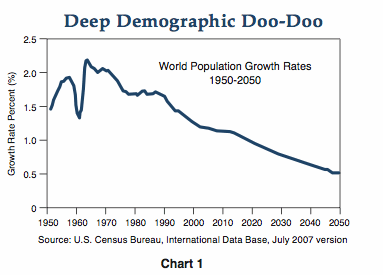More Comments From Bill Gross Of PIMCO
Posted By thestatedtruth.com on July 29, 2010
Exerts from:             Bill Gross    Investment Outlook    August 2010
Observers will point out, as shown in the following chart, that global population growth rates have been declining since 1970 with no apparent ill effects. True, until 2008, I suppose. The fact is that since the 1970s we have never really experienced a secular period during which the private market could effectively run on its own engine without artificial asset price stimulation. The lack of population growth was likely a significant factor in the leveraging of the developed world’s financial systems and the ballooning of total government and private debt as a percentage of GDP from 150% to over 300% in the United States, for example. Lacking an accelerating population base, all developed countries promoted the financing of more and more consumption per capita in order to maintain existing GDP growth rates. Finally, in the U.S., with consumption at 70% of GDP and a household sector deeply in debt, there was nowhere to go but down. Similar conditions exist in most developed economies.
The danger today, as opposed to prior deleveraging cycles, is that the deleveraging is being attempted into the headwinds of a structural demographic downwave as opposed to a decade of substantial population growth. Japan is the modern-day example of what deleveraging in the face of a slowing and now negatively growing population can do. Prior deleveraging periods such as what the U.S. and European economies experienced in the 1930s exhibited a similar demographic with the lowest levels of fertility in the 20th century and extremely low population growth. Things did not go well then. Today’s developed economies almost assuredly offer substantially less population growth than the 1.5% rate experienced over the prior 50 years. Even when viewed from a total global economy perspective, population growth over the next 10–20 years will barely exceed 1%.
The preceding analysis does not even begin to discuss the aging of this slower-growing population base itself. Japan, Germany, Italy and of course the United States, with its boomers moving toward their 60s, are getting older year after year. Even China with their previous one baby policy faces a similar demographic. And while older people spend a larger percentage of their income – that is, they save less and eventually dissave – the fact is that they spend far fewer dollars per capita than their younger counterparts. No new homes, fewer vacations, less emphasis on conspicuous consumption and no new cars every few years. Healthcare is their primary concern. These aging trends present a one-two negative punch to our New Normal thesis over the next 5–10 years: fewer new consumers in terms of total population, and a growing number of older ones who don’t spend as much money. The combined effect will slow economic growth more than otherwise.
PIMCO’s continuing New Normal thesis of deleveraging, reregulation and deglobalization produces structural headwinds that lead to lower economic growth as well as half-sized asset returns when compared to historical averages. The New Normal will not be aided nor abetted by a slower-growing population nor by cyclical policy errors that thrust Keynesian consumption remedies on a declining consumer base. Current deficit spending that seeks to maintain an artificially high percentage of consumer spending can be compared to flushing money down an economic toilet. Far better to create and mimic other government industrial policies aimed at infrastructure, clean energy, more relevant education and less costly healthcare services.
More: http://www.pimco.com/


Comments